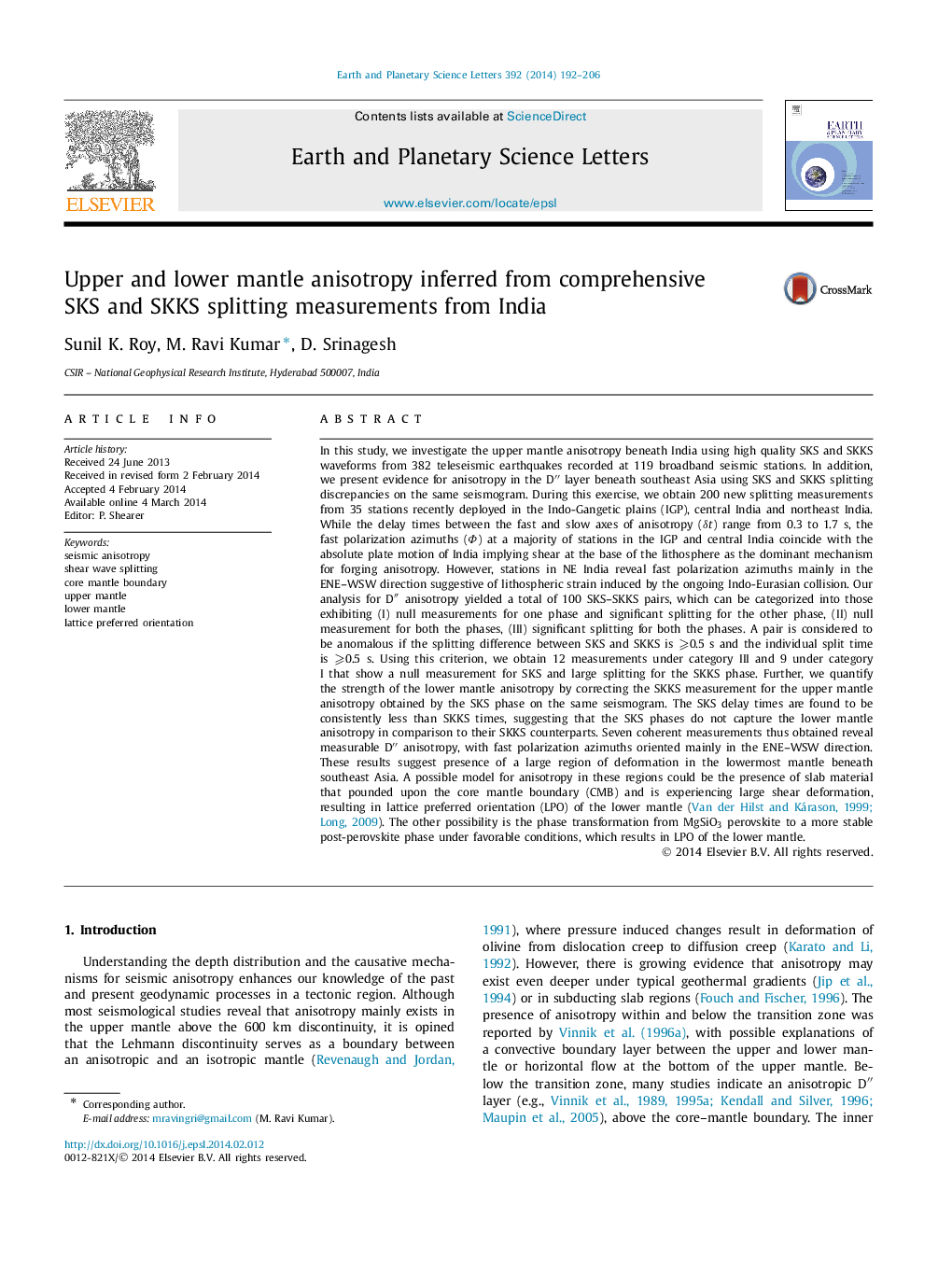| کد مقاله | کد نشریه | سال انتشار | مقاله انگلیسی | نسخه تمام متن |
|---|---|---|---|---|
| 6429505 | 1634764 | 2014 | 15 صفحه PDF | دانلود رایگان |

- Comprehensive analysis of 493 splitting measurements from 119 seismic stations.
- 200 new measurements from 35 recent deployments in Himalayan foredeep and central India.
- Lithospheric strain in the foredeep in contrast to APM dominance in cratonic India.
- 21 SKS-SKKS splitting discrepancies provide clear evidence for Dâ³ anisotropy beneath S. East Asia.
- Slab material at CMB or perovskite to post-perovskite transformation appear compatible with experimental findings.
In this study, we investigate the upper mantle anisotropy beneath India using high quality SKS and SKKS waveforms from 382 teleseismic earthquakes recorded at 119 broadband seismic stations. In addition, we present evidence for anisotropy in the Dâ³ layer beneath southeast Asia using SKS and SKKS splitting discrepancies on the same seismogram. During this exercise, we obtain 200 new splitting measurements from 35 stations recently deployed in the Indo-Gangetic plains (IGP), central India and northeast India. While the delay times between the fast and slow axes of anisotropy (δt) range from 0.3 to 1.7 s, the fast polarization azimuths (Φ) at a majority of stations in the IGP and central India coincide with the absolute plate motion of India implying shear at the base of the lithosphere as the dominant mechanism for forging anisotropy. However, stations in NE India reveal fast polarization azimuths mainly in the ENE-WSW direction suggestive of lithospheric strain induced by the ongoing Indo-Eurasian collision. Our analysis for Dâ³ anisotropy yielded a total of 100 SKS-SKKS pairs, which can be categorized into those exhibiting (I) null measurements for one phase and significant splitting for the other phase, (II) null measurement for both the phases, (III) significant splitting for both the phases. A pair is considered to be anomalous if the splitting difference between SKS and SKKS is ⩾0.5 s and the individual split time is ⩾0.5 s. Using this criterion, we obtain 12 measurements under category III and 9 under category I that show a null measurement for SKS and large splitting for the SKKS phase. Further, we quantify the strength of the lower mantle anisotropy by correcting the SKKS measurement for the upper mantle anisotropy obtained by the SKS phase on the same seismogram. The SKS delay times are found to be consistently less than SKKS times, suggesting that the SKS phases do not capture the lower mantle anisotropy in comparison to their SKKS counterparts. Seven coherent measurements thus obtained reveal measurable Dâ³ anisotropy, with fast polarization azimuths oriented mainly in the ENE-WSW direction. These results suggest presence of a large region of deformation in the lowermost mantle beneath southeast Asia. A possible model for anisotropy in these regions could be the presence of slab material that pounded upon the core mantle boundary (CMB) and is experiencing large shear deformation, resulting in lattice preferred orientation (LPO) of the lower mantle (Van der Hilst and Kárason, 1999; Long, 2009). The other possibility is the phase transformation from MgSiO3 perovskite to a more stable post-perovskite phase under favorable conditions, which results in LPO of the lower mantle.
Journal: Earth and Planetary Science Letters - Volume 392, 15 April 2014, Pages 192-206